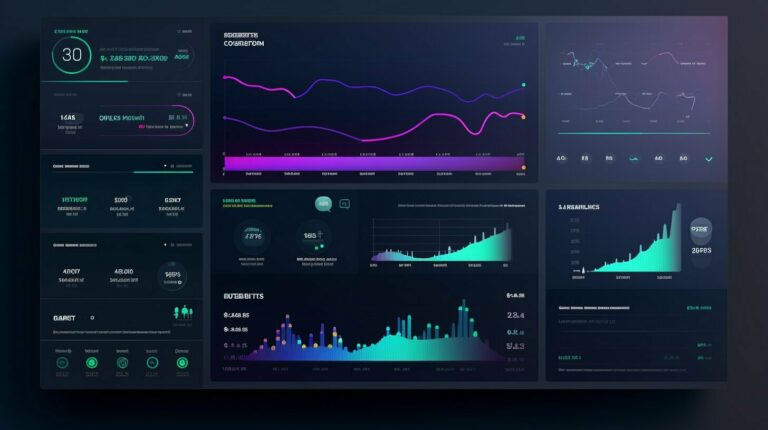Welcome to our guide on building REST APIs with Node.js and Express!
As web applications become increasingly complex, developers require a robust and efficient method for integrating diverse software systems. This is where Application Programming Interfaces (APIs) come in. APIs are a set of rules that allow different software systems to communicate and exchange data. They are essential for building flexible, scalable, and powerful web integrations.
In this guide, we will introduce the concept of building REST APIs using Node.js and Express. We will highlight the importance of API creation and discuss the relevance of Node.js and Express in this process.
Key Takeaways
- REST APIs are essential for building flexible and powerful web integrations
- Node.js and Express are widely used in API development
- APIs provide a set of rules for software systems to communicate and exchange data
Exploring Node.js and Express for API Development
When it comes to backend development, Node.js and Express are two of the most popular technologies available. These powerful tools enable developers to create robust, scalable, and efficient APIs quickly and easily. In this section, we’ll explore the key components of Node.js and Express that make them ideal for API development.
JavaScript API
One of the biggest benefits of using Node.js and Express for API development is the ability to use JavaScript throughout the entire development process. This means that developers can use one language for both the frontend and backend of their applications, streamlining the development process and reducing the potential for errors. Additionally, JavaScript is widely supported, making it an excellent choice for building APIs that can be used across multiple platforms and devices.
API Design Principles
Building a successful API requires more than just coding skills. It’s important to follow sound API design principles to ensure that the APIs created are efficient, scalable, and easy to use. This involves defining clear endpoints, using appropriate HTTP methods, and handling errors effectively. Fortunately, Node.js and Express make it easy to implement these design principles thanks to their intuitive APIs and powerful built-in features.
API Frameworks
While Node.js and Express are powerful tools on their own, developers can also take advantage of a wide range of API frameworks available in the Node.js ecosystem. These frameworks provide additional functionality, including features like database connections, authentication, and caching. Some of the most popular API frameworks for Node.js include LoopBack, Restify, and Hapi.
Overall, Node.js and Express provide developers with a powerful set of tools for building robust and scalable APIs. By following sound API design principles and taking advantage of the many frameworks available, developers can create powerful APIs that integrate seamlessly with their web applications.
Setting up a Node.js Development Environment
In order to create a Node.js API with Express, you will need to set up a development environment on your local machine. This process involves installing Node.js and familiarizing yourself with the basics of using it to build web services.
Installing Node.js
The first step in setting up your Node.js development environment is to install Node.js itself. This can typically be done by visiting the official Node.js website and downloading the latest version of Node.js for your operating system. Once downloaded, Node.js can be installed like any other software package on your machine.
Creating a Basic Web Service
After installing Node.js, you can begin creating a basic web service to get familiar with the process. This involves creating a new Node.js project, defining some basic routes, and using Express to handle incoming HTTP requests.
To create a new Node.js project, simply open a new terminal window and navigate to the directory where you want the project to be stored. Then, enter the following command:
npm init
This will create a new Node.js project in the current directory, with a package.json file that defines the project’s dependencies and other configuration details.
Next, you can install Express by running the following command:
npm install express --save
This will download and install the latest version of Express, adding it as a dependency for your project.
Once Express is installed, you can begin defining routes for your API. This involves creating a new file (usually called index.js) and using Express to define a set of endpoints that your API will respond to.
Introducing RESTful Routing Concepts
When defining routes for your Node.js API, it’s important to follow RESTful routing principles. This involves defining routes that correspond to the various HTTP methods (GET, POST, PUT, DELETE, etc.), and using appropriate status codes and response formats to communicate information to clients.
For example, a typical route definition for a GET request might look something like this:
| HTTP Method | URL | Description |
|---|---|---|
| GET | /api/users | Returns a list of all users |
By following RESTful routing principles, you can create a well-organized and easy-to-understand API that conforms to industry best practices.
Building a Basic REST API with Express
Now that we have a basic understanding of Node.js and Express, let’s dive into building a simple REST API using these tools. This API will allow users to perform CRUD (Create, Read, Update, Delete) operations on a collection of data using HTTP methods.
Note: In this tutorial, we’ll be using MongoDB as our database and Mongoose as our ORM.
Step 1: Setting up the Project
First, we need to set up our project by creating a new directory and initializing it with Node.js. We can do this by running the following commands in our terminal:
$ mkdir my-rest-api
$ cd my-rest-api
$ npm init
Next, we need to install the required dependencies. In this case, we’ll need Express, Mongoose, and body-parser. We can install these packages by running the following command:
$ npm install express mongoose body-parser
Step 2: Defining Routes
Now that we’ve set up our project and installed the required dependencies, we can define our routes. In this example, we’ll create a simple API that allows users to manage a list of books.
Let’s start by defining our Express application and creating a new instance of our router:
const express = require(‘express’);
const router = express.Router();
Next, we’ll define our routes for handling CRUD operations. Here’s an example of how we can define a route for creating a new book:
router.post(‘/books’, (req, res) => {
// create a new book
});
Step 3: Handling HTTP Methods
Now that we’ve defined our routes, we need to handle the HTTP methods that will be used to interact with our API. In this example, we’ll handle POST, GET, PUT, and DELETE methods.
Here’s an example of how we can handle the POST method for creating a new book:
router.post(‘/books’, (req, res) => {
const newBook = new Book(req.body);
newBook.save((err, book) => {
if (err) return res.status(400).json(err);
res.json(book);
});
});
We can use similar methods to handle GET, PUT, and DELETE operations.
Step 4: Interacting with a Database
We’ve defined our routes and handled the HTTP methods, but we still need to interact with our database to store and retrieve data.
In this example, we’ll be using MongoDB and Mongoose to interact with our data. Here’s an example of how we can create a new Book schema and model:
const mongoose = require(‘mongoose’);
const bookSchema = new mongoose.Schema({
title: { type: String, required: true },
author: { type: String, required: true }
});
const Book = mongoose.model(‘Book’, bookSchema);
We can then use our Book model to perform CRUD operations on our database:
// create a new book
const newBook = new Book({
title: ‘The Catcher in the Rye’,
author: ‘J.D. Salinger’
});
newBook.save();
Conclusion
In this section, we’ve covered the basics of building a REST API with Node.js and Express. We’ve defined our routes, handled HTTP methods, and interacted with a database to store and retrieve data. In the next section, we’ll explore advanced features and functionality that can be implemented in Node.js APIs created with Express.
Implementing Advanced Features and Functionality
With a basic REST API in place, it’s time to implement advanced features and functionality to enhance its performance and user experience. By integrating common API design principles, you can create a more user-friendly and intuitive interface. Here are some key features to consider:
Authentication and Authorization
APIs often handle sensitive data, so it’s vital to integrate authentication and authorization protocols. Authentication ensures the user is who they claim to be, while authorization specifies what each user can access. Implementing OAuth 2.0 or JSON Web Tokens (JWT) for authentication and authorization is a common approach.
Input Validation
Input validation ensures that data formatted properly and meets specific requirements. Including input validation in your API can prevent security vulnerabilities and errors. Express-validator provides a simple and effective way to implement input validation.
Error Handling
Effective error handling can minimize downtime and ensure smooth API operations. By using middleware error handlers in Express, API errors are caught and addressed before they impact users. Adding custom error messages and codes improves the user experience and allows for quicker resolution of issues.
Pagination
Pagination allows users to break up large sets of results into smaller, more manageable sets. By limiting the number of results per page, users can navigate the API more easily. Express-paginate is a popular middleware package for implementing pagination.
Caching
API caching stores frequently accessed data in a temporary storage location, such as the client’s browser or a server’s memory. This helps reduce the number of API requests and improves performance. Implementing caching with packages like Redis or Memcached can significantly improve API response times.
Testing and Debugging Node.js APIs
Testing and debugging are critical stages in the development of Node.js APIs built with Express. Proper testing ensures that the API functions as expected, and debugging helps in identifying and addressing any issues that may arise. In this section, we will explore testing and debugging practices for Node.js APIs built with Express.
Unit Testing
Unit testing involves testing individual components or modules of an API in isolation. This approach enables developers to catch bugs early in the development process, saving time and effort in the long run. Unit tests are typically automated and can be run repeatedly during development and deployment. There are several frameworks available for unit testing Node.js APIs, including Mocha, Jest, and Ava.
Integration Testing
Integration testing involves testing the interaction between different components or modules of an API. This approach helps ensure that the API functions as a cohesive unit and that all components work together seamlessly. Integration tests often involve testing endpoints, verifying responses, and testing data persistence. There are several tools available for integration testing Node.js APIs, including Supertest, Frisby, and Chakram.
End-to-End Testing
End-to-end testing involves testing an entire API service, including all components and modules, from start to finish. It is the closest type of testing to real-world use cases and verifies that the API functions as expected in a production environment. End-to-end tests often involve simulating user behavior, testing security, and verifying scaling capabilities. There are several tools available for end-to-end testing Node.js APIs, including Cypress, TestCafe, and Nightwatch.
Debugging
Debugging involves the process of finding and fixing errors or bugs in an API. Common debugging techniques for Node.js APIs include using console.log statements, debugging in an IDE such as Visual Studio Code, and using Node.js debuggers. Developers can also use third-party tools such as Nodemon and PM2 to help with debugging and monitoring.
Conclusion
Testing and debugging are essential stages in the development of Node.js APIs built with Express. Unit testing, integration testing, and end-to-end testing practices help ensure that the API functions as intended, while debugging techniques help identify and fix any issues that may arise. Proper testing and debugging practices result in more robust and reliable APIs, improving user experience and satisfaction.
Conclusion
In summary, building REST APIs using Node.js and Express is a powerful skill that enables developers to create seamless web integrations. As we have seen, Node.js and Express offer a vast range of features and functionalities that make them reliable tools for API development. Whether developing a small application or a large-scale project, Node.js, with its vast and active community, is a reliable programming language for creating APIs. When combined with Express, developers can build RESTful web services and APIs that offer speed, scalability, and stability.
Through this article, we have explored the key components of Node.js and Express, emphasizing the importance of API design principles and RESTful routing concepts. We have also discussed advanced features such as authentication, input validation, pagination, and caching techniques that can be implemented in Node.js APIs built with Express.
Furthermore, we have covered testing and debugging practices for Node.js APIs, including unit testing, integration testing, and end-to-end testing approaches. With these practices, developers can ensure the reliability and functionality of their APIs.
Node.js and Express: The Future of API Development
The powerful combination of Node.js and Express represents the future of API development. As the demand for seamless web integrations continues to rise, these tools offer developers the ability to create powerful and reliable REST APIs. With their active communities, vast libraries, and comprehensive documentation, Node.js and Express provide an environment where developers can easily create applications that meet the best standards of API development.







